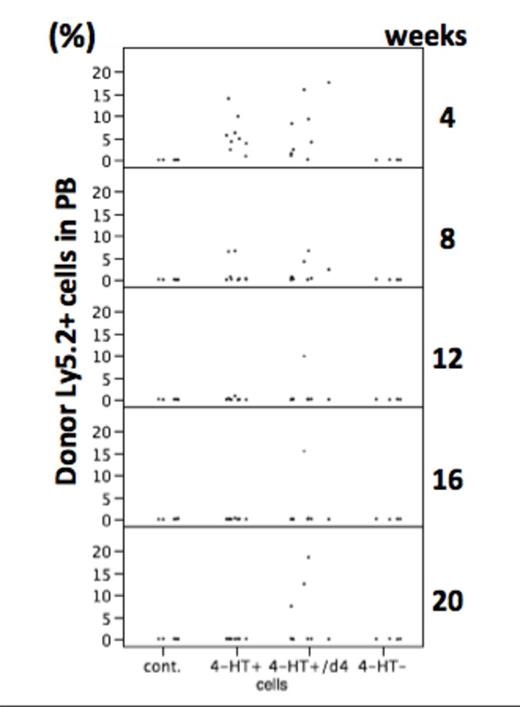Abstract
Hematopoietic stem/progenitor cells (HS/PCs) constitute a rare population of bone marrow (BM) cells and are quite unlikely to expand ex vivo with maintenance of their stemness for a prolonged period. It is also difficult to efficiently produce HSCs from embryonic stem cells (ESCs) and induced pluripotent stem cells (iPSCs). HoxB4, a member of the Homeobox (Hox) family, is an apparent positive regulator of HSC self-renewal when ectopically expressed. HoxB4 overexpression also promotes differentiation of ESCs to definitive HSCs. In this study, we examined whether conditional HoxB4 expression may contribute to efficient induction of HS/PCs from murine iPSCs. Here we report that 4-Hydroxytamoxifen (4-HT) -triggered HoxB4 can sustain iPSC-derived HS/PCs, which repopulate long-term in recipient mice, ex vivo for over two months.
GATA2 is a key transcription factor for hematopoiesis and expressed abundantly in HS/PCs. GFP-positive BM cells were prepared from C57/BL6 (Ly5.2) mice which have GFP cDNA inserted into exon 2 of the GATA2 gene, and were reprogrammed to pluripotency (GG-iPSCs) according to the standard method. HOXB4-ER cDNA encoding HoxB4-ligand binding domain of estrogen receptor chimeric protein was constructed and used to transduce GG-iPSCs (GGH-iPSCs). Transcriptional activity of HoxB4 is 4-HT-dependent in this context. Then, GGH-iPSCs were subjected to 3 different culture conditions during hematopoietic induction over an OP9 monolayer as follows. HoxB4+ and HoxB4- indicate cultures continuously supplemented with or without 4-HT throughout 2 months, respectively, and HoxB4+/d4 denotes 2 months of HoxB4+ culture followed by 4 day's depletion of 4-HT. Resulting non-adherent cells were analyzed by FACS and RT-PCR. Furthermore, to examine in vivo repopulating ability of those, HoxB4+ (n=12), HoxB4- (n=8) or HoxB4+/d4 (n=9) -derived cells were transplanted into sublethally irradiated Ly5.1 congenic mice. Control mice (n=5) were irradiated only. The ratio of peripheral blood donor cells was monitored every 4 weeks, and at 20 weeks after transplantation, lineage marker-negative (Lin-) cells from recipient BM were analyzed.
Colony-forming cells were specifically enriched in GFP+ BM cells of GATA2 knock-in mice, indicating that GGH-iPSC-derived HS/PCs can be visualized by GFP. Even after 2 months' culture of GGH-iPSCs toward hematopoietic differentiation, GFP+ cells were kept in culture and the resulting cell mass retained HS/PC signatures including RUNX1 and LMO2 in both culture conditions. However, expression of GATA2 exon1 (SI), exclusively specific for HSCs, could be detected in only HoxB4+/d4. In repopulation assays, Ly5.2+ donor cells could be detected in each group of recipient mice at 2 weeks after transplantation. Ly5.2+ cells from HoxB4- culture disappeared by 4 weeks. On the other hands, from HoxB4+ and HoxB4+/d4 cultures, Ly5.2+ cells gradually decreased in ratio and disappeared by 12 weeks, but appeared again after 16 weeks. Time to reappearance of Ly5.2+ donor cells in recipient mice was significantly shorter from HoxB4+/d4 culture than from HoxB4+ culture, suggesting that HSCs are more abundant in the former culture. Furthermore, Ly5.2+GFP+ KSL cells existed in both HoxB4+ and HoxB4+/d4, but not in HoxB4- culture. In summary, proper tuning of HoxB4 activity may be prerequisite for long-term ex vivo maintenance of iPSC-derived HS/PCs.

No relevant conflicts of interest to declare.
Author notes
Asterisk with author names denotes non-ASH members.

